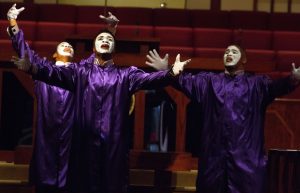Story by Joy Moton; Photos by Rachel Leland
Four young men wearing purple robes and white paint on their faces enter the sanctuary with graceful movements. As a gospel song begins to play, the group stands at the front of the church looking around frantically. Then, one dancer thrusts his hands toward the chest of another. Just as he’s seemingly about to fall, the first dancer catches his leg, stabilizing him. The young men continue to leap, spin and run with excitement along with the song’s crescendo. The congregation watches in awe as the group conveys a musical message using their bodies.
At Marlboro Heights Baptist Church in Killeen, Tyresa Conley is the youth minister and overseer of this mime group. She defines mime ministry as something that “combines miming and dancing led through worship to give glory to God and minister to the hearts of people.”

The mime ministry at Marlboro Heigh
“I started looking into ways he could minister through dance that were more powerful and more manly,” Conley said.
Around 2010, Conley tried to round up some participants for a mime routine in a Christmas play. Eight young men stepped forward. These eight took the congregation by surprise and engaged in an art form that would soon bloom into a ministry.
Mime ministries exist in churches all over the country. The use of miming to worship began with a group of twin brothers called K&K Mime in the early 1990s. With bold movements and rhythmic timing, the mimes depict powerful messages by bringing song lyrics to life with their motions.
Though Conley’s idea to start a mime group originated from a need for more masculine choreography, mime ministry isn’t limited to males.
“Not many women feel they’re able to do it, which is very off, because anyone can mime,” 18-year-old Tahj Painia said.
According to Painia, there were women who participated in the ministry until they left for college.
“Anyone can mime as long as you have the heart for it,” Painia said.
The mimes’ face paint plays a special role in the effects of their craft by symbolizing the concealment of their identities. Conley said it isn’t about the people doing the movements but the message they intend to convey.
“Like any sport, if I’m in mask then I’m more free to do what I want to do,” Conley said.
The paint also serves to draw away from the individuals’ faces so that witnesses will pay more attention to the motions of their bodies.
“When you use your body, it actually paints the picture of what the message is saying,” Anderson said. “It’s actually giving a clear image of what you’re dealing with.”
There is a significant difference between pantomiming and miming for ministry. These eight young men make it clear that miming for ministry isn’t a matter of entertainment.
“You can just do this out of it looks cool or whatever, but if there’s no ministry in it then there’s no point,” Anderson said. “You won’t fulfill the purpose of what mime ministry is.”
As a ministry group composed of African-American men, a significant portion of their impact comes from the group’s opposition to racial and gender-specific stereotypes.
“We understand that there’s a lot of stereotypes that go into it and they’re battling that every time they stand,” Conley said.
In spite of a society where teenage males are commonly portrayed negatively, these young men desire to use the ministry to portray hope to the congregation.

“I feel like it brings a resurgence of hope to the community and it kind of battles the idea that all black men are the stereotype of trouble,” Painia said.
It’s important to include art in ministry because art is a large part of life, Conley said. She described how the most popular songs in our culture include dance.
“I think it just aids to support it in a way that grabs people, unlike just directly,” Conley said.
To Conley, people shouldn’t get so stuck on tradition that they allow God-given talent to go to waste. Just as there are amazing talents being used to gain fame, there are remarkable gifts that could be used for the mission of the church, Conley said.
The mimes say they cherish the brotherhood in this ministry. Anderson described his connection with the team, which was particularly significant after growing up in a single-parent home as an only child. To Anderson, the absence of his father has been tough and growing up without siblings has made him feel isolated.
“I feel like every boy needs his father,” Anderson said. “Every boy needs a manly figure, period.”
After growing in the mime ministry, Anderson said he no longer feels alone and has found something even greater than dear friends.
“I’m an only child, but when I’m here in this ministry I feel like there’s brotherhood,” Anderson said.
The impact of mime ministry has affected each individual on the team uniquely, just as much as it has impacted those who watch the mimes perform.
At the age of seven, Painia’s life was changed after moving to Texas in the aftermath of Hurricane Katrina. He was not aware that his family was leaving New Orleans for good until he got to Texas.
“It was very tough seeing my mother and father trying to deal with moving from a place where they’ve grown up,” Painia said.
After living in Texas for five years and finally arriving at a new church, Painia said that in spite of his timidity, the young men with whom he now dances were welcoming toward him.
“They opened their arms to me to accept me and it was a smooth fit,” Painia said.
After dancing with the mime ministry, people noticed him and admired his passion.
“Mime ministry has drawn me closer not only to God but to other people and made me more social,” Painia said.
The mimes say they hope the ministry will continue at Marlboro Heights long after they graduate. According to Conley, this form of art is significant to ministry because it conveys unforgettable images that speak to people.
“It shows what God can do and it shows who he is at the same time, and I believe when you have those two as one it creates something beautiful,” Anderson said.

